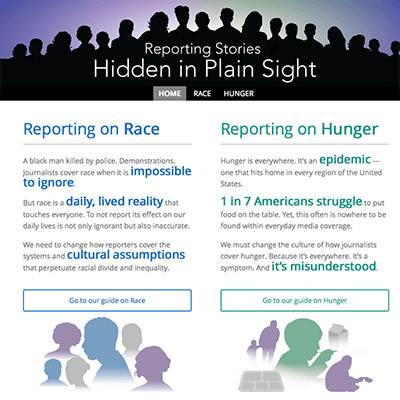What do you do when the protests stop and racism remains?
New resource helps journalists cover race and hunger
Last November, the president of the four-campus University of Missouri System resigned in the wake of protests calling for an end to systemic racism at MU. The top executive at the Columbia campus also stepped down. A graduate student ended an eight-day hunger strike. And a Division 1 college football team stopped its boycott.
Covering these adrenaline-pumping events was exciting, exhausting and, in one sense, easy. Journalists know how to cover breaking news.
In September 2015, the local food bank unveiled a 16-foot, 212-pound orange spoon. The purpose: to raise awareness of the 16.9 percent of Missourians who experience food insecurity. The recipe for coverage was easy. Assign a photojournalist and a reporter to cover the speeches. File a daily article.
But hunger in a state with 28 million acres devoted to agriculture remains a deep concern. What do you do beyond official pronouncements and spoon-fed events?
Hunger and race are two topics communities face every day. Few news organizations can sustain coverage of either over time. Our options grow even more limited as we work with fewer people for companies that expect them to file in multiple ways on multiple platforms.
How do we find and cover these stories, then? Reporting Stories Hidden in Plain Sight, a new web-based resource for journalists, is our first response.
The site contains a lot of literacy – definitions of terms, timelines and links to key data sets. There are also examples of good coverage of race and hunger and academic reports on the issues.
A student journalism team focusing on issues of race (more on that below) organized coverage by traditional beats. The point is to insert better reporting within what journalists already do. For example, a health reporter can identify misconceptions about race among the medical community. Did you know that doctors in one study were twice as likely to underestimate the pain in black patients than all other ethnicities combined?
A second student team, which was focused on hunger, began with the assumption that few news organizations can dedicate a single beat to hunger. So the strategy was to find a connection to hunger in all beats.
As with many complicated issues, some information about hunger and race overlap. A demographic profile shows, for instance, that one in four African-American households are food insecure compared to one in 10 white households.
Students at the Missouri School of Journalism reported out issues of race and hunger as semester-long projects in a capstone class. The purpose was to produce insights and information for journalists to use, whether they are covering an event or a longer project.
Partnering with the Donald W. Reynolds Journalism Institute, the class demonstrated how small teams of trained, soon-to-be journalists – most graduated in May – can help fellow practitioners with practical solutions.
The Missouri Method in journalism education has been predicated on the notion that students learn best by a combination of theory and real-world practice in the school's professional newsrooms and advertising agencies.
That means students enroll in staff classes to create journalism for:
- Columbia Missourian website and print edition.
- Vox Magazine.
- Global Journalist.
- KBIA-FM, Mid-Missouri Public Radio.
- KOMU-TV, an NBC affiliate.
They also apply for classes in strategic communications that take on major national brands as clients.
Through RJI, there are opportunities for students to work on innovative projects in other classes as well. One such project led to digital-first changes in the Missourian newsroom some five years before The New York Times began dethroning the primacy of print in daily budget meetings.
For this project, RJI partnered with the capstone Journalism and Democracy class. It hired two talented journalists, Laura Stanton and David LaGesse, to lead the website design from the beginning of brainstorming right through to implementation. Longtime editor and professor Jeanne Abbott edited the content, and I followed behind her.
Students were sometimes flabbergasted, sometimes irked by some of the coverage they found. Early on, after reviewing the first 10 pages of a Google search on hunger, one student noted, "Instead of talking about people, many news stories still focus on the number, the general problem, or related organizations."
So they started digging, using local sources for experience and nationally known reporters for advice.
We all too often think of innovation as an app. The Next Big Thing in technology. But innovation can come simply in the way we work. Can I tweak what I do as a reporter or editor in a way that will have real payoffs – in a way that helps my community solve its problems?
Some of the most intractable issues are the ones lying at our feet every day like a nest of snakes: poverty, environmental change, racism. The loss of civility in our civic life. Nativism. Sexism.
The hard work lies between the next flame of protest. We can do better on big issues in our everyday reporting.
Journalism schools can help.
To learn more about Hidden Stories – or to suggest additional content or resources – contact Tom Warhover or Jeanne Abbott.
Tom Warhover is an associate professor at the Missouri School of Journalism and executive editor of the Columbia Missourian, a newspaper managed by professionals and staffed by students.









